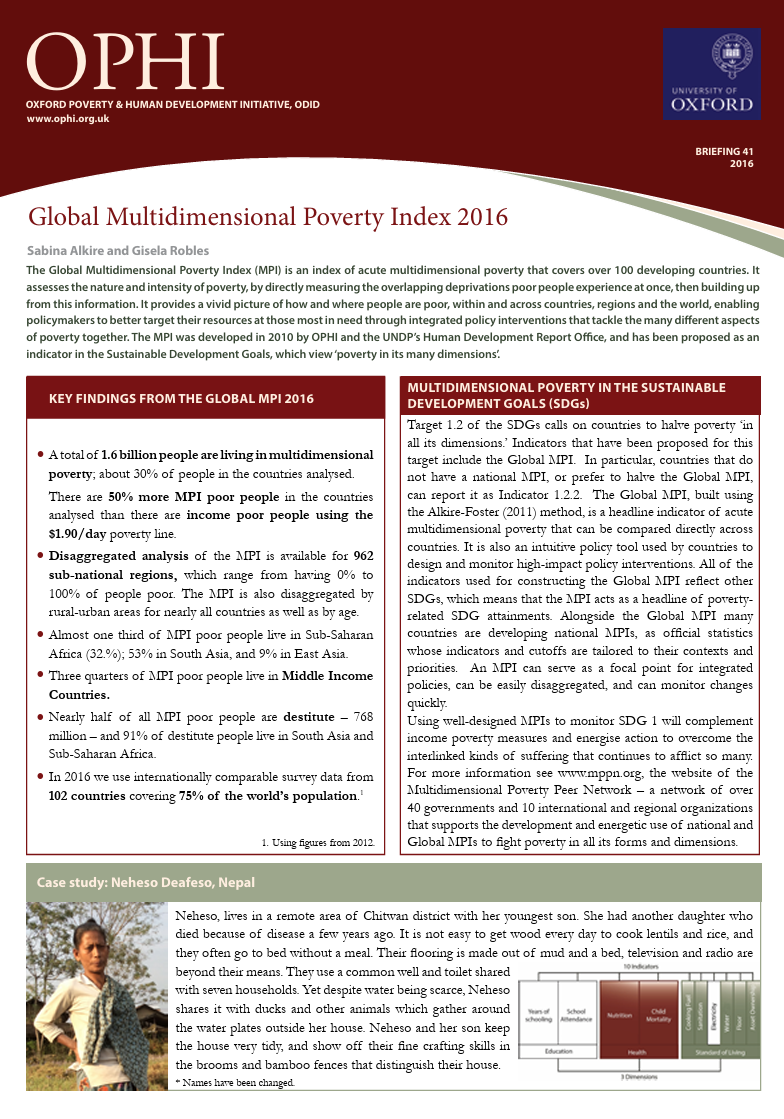Global MPI 2016
The 2016 global Multidimensional Poverty Index (MPI) covers 102 countries covering 75% of the world’s population. A total of 1.6 billion people are living in multidimensional poverty; about 30% of people in the countries analysed. Disaggregated analysis of the MPI is available for 962 sub-national regions. In 2016, OPHI focuses analysis on 46 countries in Africa, which are home to just over 1 billion people. Of these, 54% of the population, 544 million people, are multidimensionally poor.
Our briefings
In 2016, the global MPI results were explored in a series of briefing papers:
- Alkire, S. and Robles, G. (2016). ‘Global Multidimensional Poverty Index 2016’, OPHI Briefing 41, Oxford Poverty and Human Development Initiative (OPHI), University of Oxford. (2 pages)
- Alkire, S. Jindra, C., Robles, G. and Vaz, A. (2016). ‘Multidimensional Poverty in Africa’, OPHI Briefing 40, Oxford Poverty and Human Development Initiative (OPHI), University of Oxford.
- Alkire, S. Jindra, C., Robles, G. and Vaz, A. (2016). 'Pauvreté multidimensionelle en Afrique', OPHI Briefing 43, Oxford Poverty and Human Development Initiative (OPHI), University of Oxford.
Our data
Summer Data Tables
- Data Tables 1.1-2.3
Main MPI results, headcount ratio by dimensions, contribution of deprivations and other measures of poverty and wellbeing at the national level (102 countries) - Data Tables 3.1-4.3
Multidimensional poverty, headcount ratio by dimension and contribution of deprivations in rural and urban areas (100 countries) - Data Tables 5.1-5.4
Multidimensional poverty, headcount ratio by dimension and contribution of deprivations at the sub-national level (962 regions of 78 countries) - Data Tables 6.1-6.6
Changes to MPI poverty over time, including annualised changes in headcount ratio and intensity, changes in each indicator at the national level and changes in destitution where available (50 countries) - Data Table 7
The table presents an archive of all MPI estimations published since 2010. These are not harmonised for comparisons over time (for harmonised estimations see Table 6). Table 7 covers 232 estimations for 118 countries in 2016.
Winter Data Tables
- Data Tables 1.1-2.3
Main MPI results, headcount ratio by dimensions, contribution of deprivations and other measures of poverty and wellbeing at the national level (103 countries). - Data Tables 3.1-4.3
Multidimensional poverty, headcount ratio by dimension and contribution of deprivations in rural and urban areas (101 countries) - Data Tables 5.1-5.4
Multidimensional poverty, headcount ratio by dimension and contribution of deprivations at the sub-national level (962 regions of 77 countries) - Data Table 7
The table presents an archive of all MPI estimations published since 2010. These are not harmonized for comparisons over time (for harmonized estimations see Table 6 from summer 2016 update). Table 7 covers 241 estimations for 119 countries in Winter 2016.
Our Country Briefings
The global MPI Country Briefings present the country-specific results for the countries in this year’s global MPI. In 2016, we published Country Briefings in June and December.



